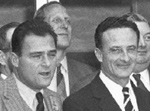|
TODD-AO PROCESS HISTORY |
 How
Todd-AO Began How
Todd-AO Began
By Brian O'Brien, Jr.
My father was a
college professor, uninterested in show
business, and had never heard of Mike Todd, so
when Mike called him late one night saying he
wanted a meeting, my dad was naturally cautious.
Finally, he called one night and said "OK Doctor, I give up. I
have been looking into the companies you mentioned and American Optical
looks like the best bet. What do I do now?" "Fine" said my dad,
"I am having
lunch with Walter Stewart, President of AO next Tuesday.
Why do you not come up to Southbridge and have lunch with us?". |
 Todd-AO
Birth date Todd-AO
Birth date
By Brian O'Brien
On October 15th, 1952 I received a phone call
from a Michael Todd in New York City, who wished
to come to see me at Rochester that evening. I
had never heard of Todd, but it seems that he is
a well-known Broadway producer. |
 Brian O'Brien, Jr.
tracks American Optical Co's development of the Todd-AO process Brian O'Brien, Jr.
tracks American Optical Co's development of the Todd-AO process
By Thomas Hauerslev
Between 1953 and 1956,
Brian O'Brien, Jr.'s secretary made a scrapbook with newspaper and
trade magazine clips about the development of Todd-AO.
A green ring binder with 132 pages of clippings, adverts and stories
about one of the most significant films formats from the 20th century. It
has been one of my goals to make all this available on in70mm.com for many
years. Here it is as PDF files, and organized page by page in a very low-tech manner. |
 Brian O'Brien Biography Brian O'Brien Biography
By Walter P. Siegmund and Brian O'Brien, Jr.
Brian O'Brien was born in Denver, Colorado, in 1898 to Michael Phillip and
Lina Prime O'Brien. His education started in the Chicago Latin School from
1909–1915, and continued at the Yale Sheffield scientific school where he
earned a Ph.B. in 1918 and a Ph.D. in 1922. In 1922 he married Ethel
Cornelia Dickerman and they had one son, Brian, Jr.. |
 Todd-AO
Conference 1954 at American Optical Company
Research Center Todd-AO
Conference 1954 at American Optical Company
Research Center
By Brian O'Brien, Jr
The people on the picture are from left to right: Skyler Sanford, Bob Surtees,
Brian O'Brien, Jr., Walter Siegmund, Mike Todd, Steve Macnielle, Fred Zinneman, Art Miller,
Brian O'Brien, Oscar Hammerstein, Arthur Hornblow |
|
|
|
|
|
TODD-AO STORY |
 In the Splendour of 70mm In the Splendour of 70mm
By Grant Lobban
While working on "This Is Cinerama"
Michael Todd became convinced that there must be an
easier way of achieving the same "wrap around" effect
using only one projector and a single strip of film.
|
 Grant's Blow-up Blog Grant's Blow-up Blog
By Grant Lobban
A blow-up is the term used to describe a
print made by enlarging, or
“blowing-up”, smaller formats, usually
those on 35mm film, but 70mm prints have
also been derived from 16mm and even 8mm
originals. |
 Todd-AO
The Show of Shows Todd-AO
The Show of Shows
By John Belton
"Oklahoma!" was a hot ticket; even Cecil B. DeMille had trouble getting seats during the first few weeks of its run.
Todd-AO was about showman-ship. It provided high quality
subject matter, lavish production values, big screen
entertainment, and six-track stereo magnetic sound. |
 The
Amazing Optical Adventures of Todd-AO The
Amazing Optical Adventures of Todd-AO
By Jeff Hecht
Todd had
just launched Cinerama, a wide-screen system that put the
audience in the middle of the action. Yet he knew the
cumbersome three-projector Cinerama system dated from before
World War II, and had split with his partners even before
the first Cinerama film opened. |
 Hollywood
Comes to American Optical Co. Hollywood
Comes to American Optical Co.
Roy C. Gunter Jr.
O'Brien was interested in what Todd said about Cinerama and sent Siegmund to New York to look at the system.
He reported back to O'Brien that while the optical system
was not really sophisticated, the audience response to the wide screen was
clearly favorable. |
|
|
|
| |